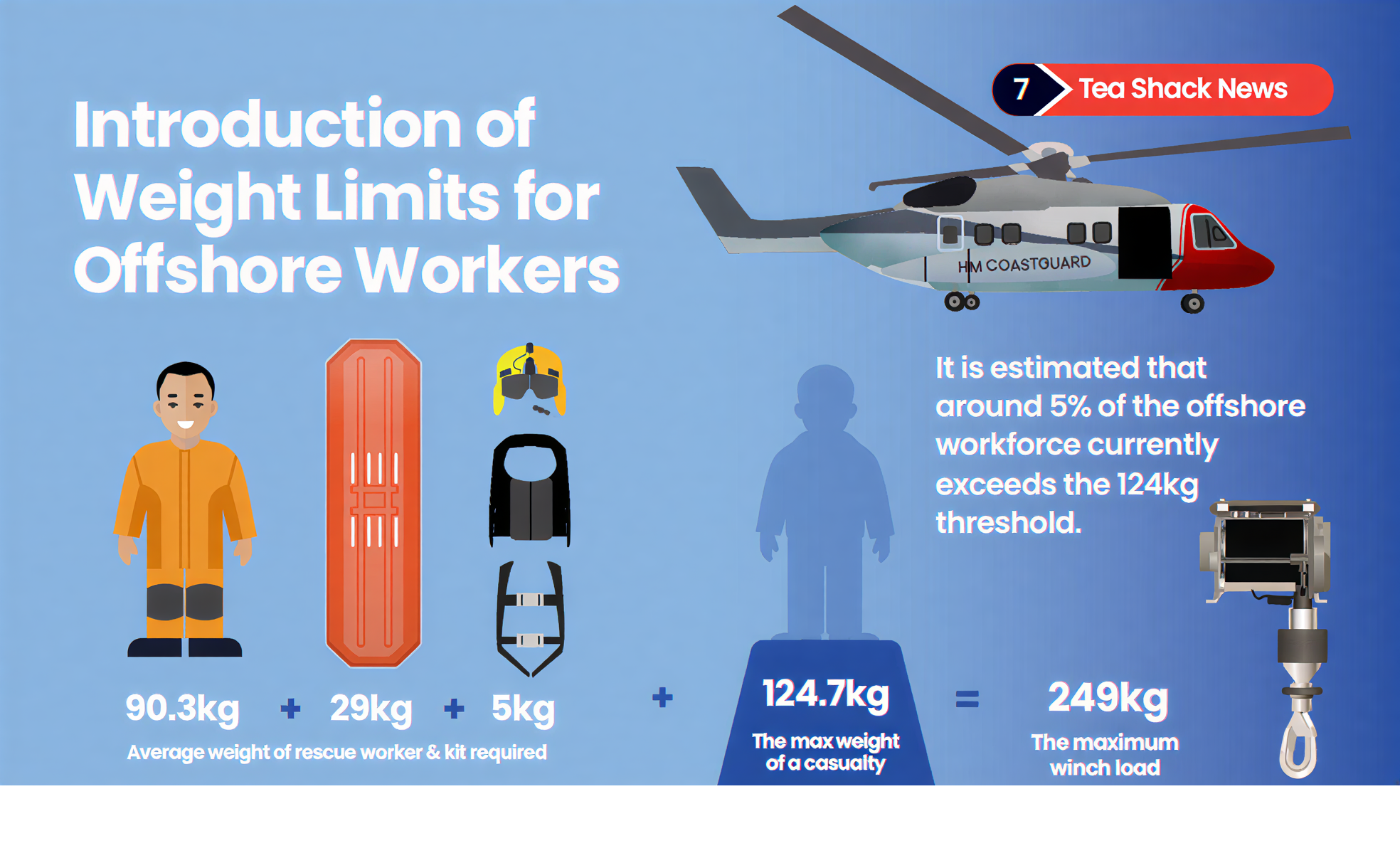Safe weight limit policy
Working together for a safer offshore workforce

The UK offshore energy industry has come together to introduce a Safe Weight Limit Policy to ensure the safety of all personnel working offshore.
This industry-wide initiative has been developed following extensive engagement between OEUK, HM Coastguard, helicopter operators, and member companies. It addresses increasing worker weights and the associated challenges for evacuation, rescue, and medical response offshore.
- About the policy
- Why it's needed
- Industry collaboration and support
The clothed weight limit for offshore workers is 124kg, including a 0.7kg margin.
“Clothed weight” refers to a person’s weight while dressed in accordance with the industry travel clothing policy for the relevant season.
The policy applies to all offshore installations operating under accepted Safety Cases as defined in the Offshore Installations (Offshore Safety Directive) (Safety Case etc.) Regulations 2015.
Over the past 60 years, average body weights have steadily increased, and over a third of offshore workers now weigh more than 100kg, with nearly 5% above 125kg.
This poses serious challenges for lifeboat evacuation, helicopter rescue, and safe handling in emergency situations.
Search and Rescue (SAR) helicopters in the UK, Norway, and the Netherlands use winches certified to a maximum lift capacity of 124.7kg for a patient, once the winchman and rescue equipment are accounted for.
Anyone above this weight may not be guaranteed rescue in an emergency.
This limitation, combined with other offshore safety risks, makes it vital that installations ensure every worker can be safely evacuated or rescued if required.
This policy was developed through collaboration between OEUK members, HM Coastguard, and other industry bodies.
HM Coastguard has confirmed that helicopter winch systems are subject to strict certification under the European Union Aviation Safety Agency (EASA), and increasing their capacity is not feasible in the short term.
OEUK continues to engage with HM Coastguard and helicopter providers to explore technical improvements, including the potential for lighter rescue equipment.
Key Facts
Summary of the Safe Weight Limit Policy for Offshore Installations
Clothed Weight Limit: 124 kg
Applies to all offshore workers, including a 0.7 kg safety margin. Ensures every person can be safely evacuated or rescued, particularly by search and rescue (SAR) helicopter winch.
Implementation Phases
1 Nov 2025 – 31 Jan 2026: Introduction & Awareness
1 Feb – 31 Oct 2026: Transition
From 1 Nov 2026: Mandatory compliance – workers >124 kg cannot travel offshore.
Helicopter Winch Limit
The combined load of the winchman, stretcher and equipment leaves a maximum capacity of 124.7 kg for a patient. Anyone above this weight cannot be guaranteed rescue by SAR helicopter.
Number of Workers Affected
OEUK estimates around 5,000 offshore workers may be affected to varying degrees. Most are expected to meet the limit through gradual weight reduction.
Medical Certification
During the transition phase, OEUK medical examiners will issue reduced-duration certificates for individuals near or above 124 kg. After 1 Nov 2026, no certificate will be issued to anyone exceeding 124 kg.
Clothed Weight Definition
Measured with the worker dressed according to the industry travel clothing policy for the relevant season, including shoes. This is the practical and standard measure used at heliports.
Support for Workers
Employers are encouraged to provide access to weight-management and wellbeing programmes. Resources will be shared by OEUK and Step Change in Safety throughout late 2025.
Scope of the Policy
The limit applies to offshore installations with accepted Safety Cases under the 2015 Offshore Safety Directive. It does not apply to marine vessels, which are governed by different regulations.
Outbound Flights Only
The restriction applies only to outbound (offshore) flights. There are no weight restrictions for return flights to shore.
Policy Review
OEUK will continue to review the policy based on operational experience, legal developments and stakeholder feedback.
Implementation timeline
-
01.
Introduction & Awareness Phase
1 November 2025 – 31 January 2026
During this period, OEUK and employers will raise awareness of the policy. Workers will receive information on what the policy means and the support available.
No restrictions apply yet, but this is the ideal time to start preparing.
-
02.
Transition Phase
1 February 2026 – 31 October 2026
Workers above the 124kg limit should take steps to reduce weight.
OEUK medical examiners may issue reduced-duration medical certificates to ensure individuals are aware of the approaching compliance deadline.
Employers are encouraged to provide access to health and weight management support programmes, with additional resources from Step Change in Safety.
-
03.
Mandatory Implementation
From 1 November 2026
After this date, anyone exceeding 124kg will not be permitted to travel offshore and will not receive a valid medical certificate.
Workers may be asked to confirm their weight before mobilisation.
Documents and resources
The following materials support the Safe Weight Limit Policy and can be downloaded from this page once published:
Contact
For further information, contact your employer or reach out to OEUK’s Health & Safety Team.
